| |||
|---|---|---|---|
| +... |
| Years in film |
|---|
 |
| 19th century |
| 1870s |
The following is an overview of the events of 1895 in film, including a list of films released and notable births.
| |||
|---|---|---|---|
| +... |
| Years in film |
|---|
 |
| 19th century |
| 1870s |
The following is an overview of the events of 1895 in film, including a list of films released and notable births.

| Month | Date | Name | Country | Profession | Died | |
| January | 5 | A. Edward Sutherland | US | Director, Actor | 1973 | |
| 23 | Raymond Griffith | US | Actor | 1957 | ||
| February | 7 | Anita Stewart | US | Actress, Producer | 1961 | |
| 19 | Louis Calhern | US | Actor | 1956 | ||
| 21 | Charles King | US | Actor | 1957 | ||
| 25 | Einar Axelsson | Sweden | Actor | 1971 | ||
| March | 11 | Shemp Howard | US | Actor | 1955 | |
| 24 | Syd Saylor | US | Actor | 1962 | ||
| 25 | Valéry Inkijinoff | Russia | Actor | 1973 | ||
| 27 | Betty Schade | Germany | Actress | 1982 | ||
| April | 7 | Margarete Schön | Germany | Actress | 1985 | |
| May | 6 | Rudolph Valentino | Italy | Actor | 1926 | |
| June | 24 | Jack Dempsey | US | Boxer, Actor | 1983 | |
| July | 9 | Cullen Landis | US | Actor, Director | 1975 | |
| 13 | Sidney Blackmer | US | Actor | 1973 | ||
| 21 | Henry Lynn | US | Director, Screenwriter | 1984 | ||
| 25 | Ingeborg Spangsfeldt | Denmark | Actress | 1968 | ||
| 26 | Gracie Allen | UK | Actress | 1964 | ||
| August | 9 | Nat Pendleton | US | Olympic Wrestler, Actor | 1967 | |
| 16 | Lucien Littlefield | US | Actor | 1960 | ||
| September | 11 | Uno Henning | Sweden | Actor | 1970 | |
| 22 | Paul Muni | Austria | Actor | 1967 | ||
| October | 4 | Buster Keaton | US | Actor, Director | 1966 | |
| 20 | Evelyn Brent | US | Actress | 1975 | ||
| 21 | Edna Purviance | US | Actress | 1958 | ||
| November | 14 | Louise Huff | US | Actress | 1973 | |
| December | 3 | Tadeusz Olsza | Poland | Actor | 1975 | |

The Lumière brothers, Auguste Marie Louis Nicolas Lumière and Louis Jean Lumière, were French manufacturers of photography equipment, best known for their Cinématographe motion picture system and the short films they produced between 1895 and 1905, which places them among the earliest filmmakers.
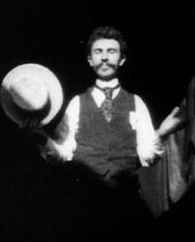
William Kennedy Laurie Dickson was a British-American inventor who devised an early motion picture camera under the employment of Thomas Edison.
The following is an overview of the events of 1896 in film, including a list of films released and notable births.
The following is an overview of the events of 1894 in film, including a list of films released and notable births.
A movie camera is a type of photographic camera that rapidly takes a sequence of photographs, either onto film stock or an image sensor, in order to produce a moving image to display on a screen. In contrast to the still camera, which captures a single image at a time, the movie camera takes a series of images by way of an intermittent mechanism or by electronic means; each image is a frame of film or video. The frames are projected through a movie projector or a video projector at a specific frame rate to show the moving picture. When projected at a high enough frame rate, the persistence of vision allows the eyes and brain of the viewer to merge the separate frames into a continuous moving picture.
The following is an overview of the events of 1892 in film, including a list of films released and notable births.
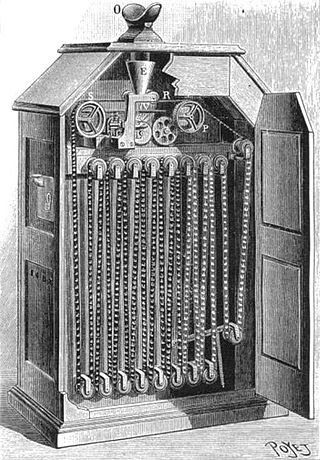
The Kinetoscope is an early motion picture exhibition device, designed for films to be viewed by one person at a time through a peephole viewer window. The Kinetoscope was not a movie projector, but it introduced the basic approach that would become the standard for all cinematic projection before the advent of video: it created the illusion of movement by conveying a strip of perforated film bearing sequential images over a light source with a high-speed shutter. First described in conceptual terms by U.S. inventor Thomas Edison in 1888, it was largely developed by his employee William Kennedy Laurie Dickson between 1889 and 1892. Dickson and his team at the Edison lab in New Jersey also devised the Kinetograph, an innovative motion picture camera with rapid intermittent, or stop-and-go, film movement, to photograph movies for in-house experiments and, eventually, commercial Kinetoscope presentations.

The Biograph Company, also known as the American Mutoscope and Biograph Company, was a motion picture company founded in 1895 and active until 1916. It was the first company in the United States devoted entirely to film production and exhibition, and for two decades was one of the most prolific, releasing over 3000 short films and 12 feature films. During the height of silent film as a medium, Biograph was the most prominent U.S. film studio and one of the most respected and influential studios worldwide, only rivaled by Germany's UFA, Sweden's Svensk Filmindustri and France's Pathé. The company was home to pioneering director D. W. Griffith and such actors as Mary Pickford, Lillian Gish, and Lionel Barrymore.
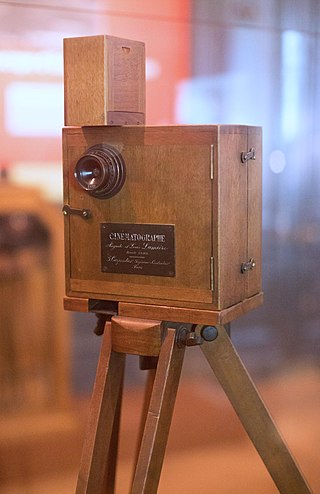
Cinematograph or kinematograph is an early term for several types of motion picture film mechanisms. The name was used for movie cameras as well as film projectors, or for complete systems that also provided means to print films.

Vitascope was an early film projector first demonstrated in 1895 by Charles Francis Jenkins and Thomas Armat. They had made modifications to Jenkins' patented Phantoscope, which cast images via film and electric light onto a wall or screen. The Vitascope is a large electrically-powered projector that uses light to cast images. The images being cast are originally taken by a kinetoscope mechanism onto gelatin film. Using an intermittent mechanism, the film negatives produced up to fifty frames per second. The shutter opens and closes to reveal new images. This device can produce up to 3,000 negatives per minute. With the original Phantoscope and before he partnered with Armat, Jenkins displayed the earliest documented projection of a filmed motion picture in June 1894 in Richmond, Indiana.

Birt Acres was an American and British photographer and film pioneer. Among his contributions to the early film industry are the first working 35 mm camera in Britain (Wales), and Birtac, the first daylight loading home movie camera and projector. He also directed a number of early silent films.

Actuality film is a non-fiction film genre that uses footage of real events, places, and things, a predecessor to documentary film. Unlike documentaries, actuality films are not structured into a larger narrative or coherent whole. During the era of early cinema, actualities—usually lasting no more than a minute or two and usually assembled together into a program by an exhibitor—were just as popular and prominent as their fictional counterparts. The line between "fact" and "fiction" was not as prominent in early cinema as it would become once documentaries became the predominant non-fiction filmmaking form. Actuality as a film genre is related to still photography.

Robert William Paul was an English pioneer of film and scientific instrument maker.

Max Skladanowsky was a German inventor and early filmmaker. Along with his brother Emil, he invented the Bioscop, an early movie projector the Skladanowsky brothers used to display a moving picture show to a paying audience on 1 November 1895, shortly before the public debut of the Lumière Brothers' Cinématographe in Paris on 28 December 1895.

Herman Casler was an American inventor and co-founder of the partnership called the K.M.C.D. Syndicate, along with W.K-L. Dickson, Elias Koopman, and Henry N "Harry" Marvin, which eventually was incorporated into the American Mutoscope Company in December 1895.
The decade of the 1890s in film involved some significant events.
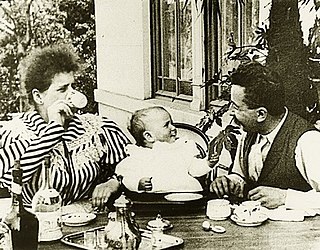
Repas de bébé is a 1895 French short black-and-white silent actuality film photographed by Louis Lumière and showing his brother Auguste Lumière and Auguste's wife Marguerite feeding their infant daughter, Andrée Lumière.

The Latham Loop is used in film projection and image capture. It isolates the filmstrip from vibration and tension, allowing movies to be continuously shot and projected for extended periods.
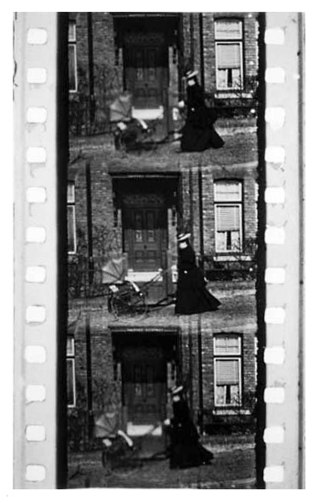
Incident at Clovelly Cottage, also known as Incident Outside Clovelly Cottage, Barnet, shot by Birt Acres and produced by Acres and his collaborator Robert W. Paul in March 1895, was the "first successful motion picture film made in Britain".